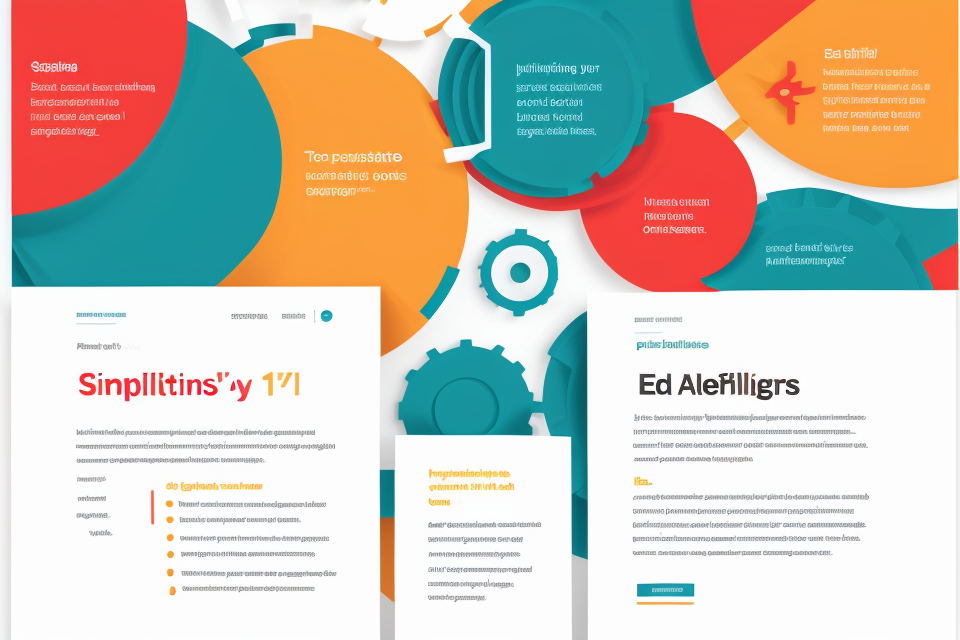
Optimization is a critical aspect of software development that aims to enhance the performance of software applications. It involves the use of various techniques and strategies to improve the efficiency and effectiveness of software systems. One of the most important rules of optimization is to ensure that it is done with a focus on maximizing efficiency. This means that optimization should be geared towards achieving the best possible results with the least amount of effort and resources.
In software development, the first rule of optimization is to prioritize efficiency over speed or other factors. This means that developers should aim to optimize software systems in a way that maximizes their efficiency and effectiveness, rather than simply focusing on achieving the fastest possible results. By prioritizing efficiency, developers can create software systems that are more efficient, reliable, and scalable, which can lead to better overall performance and a more positive user experience.
In conclusion, the first rule of optimization in software development is to prioritize efficiency over speed or other factors. This involves using techniques and strategies that are designed to enhance the efficiency and effectiveness of software systems, rather than simply aiming for the fastest possible results. By following this rule, developers can create software systems that are more efficient, reliable, and scalable, which can lead to better overall performance and a more positive user experience.
Understanding Software Optimization
Importance of Software Optimization
In the world of software development, optimization plays a crucial role in enhancing the overall performance of a system. There are several reasons why software optimization is essential, including:
- Improving system performance: By optimizing software, it is possible to improve the speed and efficiency of a system. This can be achieved by reducing the amount of time it takes to complete tasks, minimizing the amount of resources required to run the system, and improving the overall responsiveness of the software.
- Enhancing user experience: When software is optimized, it can provide a better user experience. This can be achieved by reducing the amount of time it takes to load pages, minimizing the amount of data that needs to be transferred, and improving the overall responsiveness of the software.
- Reducing resource consumption: Optimizing software can help to reduce the amount of resources required to run a system. This can be achieved by reducing the amount of memory required to run the software, minimizing the amount of data that needs to be stored, and reducing the amount of processing power required to run the system.
Overall, software optimization is essential for improving the performance of a system, enhancing the user experience, and reducing resource consumption. By implementing optimization techniques, software developers can create more efficient and effective software that meets the needs of users and businesses alike.
Common Optimization Techniques
Optimizing software is an essential aspect of software development, as it aims to improve the performance and efficiency of a program. There are several common optimization techniques that can be applied to achieve this goal. In this section, we will discuss some of the most commonly used optimization techniques in software development.
Code Optimization
Code optimization involves making changes to the source code of a program to improve its performance. This can include techniques such as loop unrolling, function inlining, and code simplification. By optimizing the code, developers can reduce the execution time of a program and improve its overall efficiency.
Database Optimization
Database optimization involves improving the performance of a database by optimizing the way data is stored, accessed, and retrieved. This can include techniques such as indexing, query optimization, and database partitioning. By optimizing the database, developers can improve the speed and efficiency of data access, reduce the amount of data that needs to be transferred, and minimize the amount of storage space required.
Memory Management
Memory management is an essential aspect of software optimization, as it involves managing the allocation and deallocation of memory in a program. This can include techniques such as memory pooling, garbage collection, and memory compression. By optimizing memory management, developers can reduce the amount of memory required by a program, minimize memory leaks, and improve the overall efficiency of the program.
Overall, these common optimization techniques can help developers improve the performance and efficiency of their software. By applying these techniques, developers can create software that is faster, more efficient, and more reliable, ultimately providing a better user experience.
The First Rule of Optimization
Rule #1: Identify Bottlenecks
When it comes to optimizing software development, the first rule is to identify bottlenecks. Bottlenecks refer to areas of the system that are causing slow or resource-intensive processes, and they need to be pinpointed in order to improve efficiency.
Identifying bottlenecks can be done by analyzing system performance. This can be done through various means, such as monitoring system logs, using performance testing tools, or conducting load testing. By analyzing system performance, you can identify areas where the system is under stress and determine which processes are causing the slowdowns.
Once you have identified the bottlenecks, the next step is to detect slow or resource-intensive processes. This can be done by measuring the response time of the system and comparing it to expected performance levels. If the response time is significantly higher than expected, it could indicate a bottleneck.
Once you have identified the slow or resource-intensive processes, the next step is to pinpoint areas for improvement. This can involve optimizing code, upgrading hardware, or implementing caching mechanisms. By implementing these improvements, you can reduce the impact of bottlenecks and improve overall system performance.
It’s important to note that identifying bottlenecks is just the first step in optimizing software development. Once you have identified the bottlenecks, you need to take action to address them. This may involve making changes to the code, upgrading hardware, or implementing caching mechanisms. Whatever the solution, it’s important to take action to improve efficiency and ensure that the system is running at optimal levels.
Rule #2: Prioritize Critical Tasks
In software development, it is essential to focus on tasks that have the most significant impact on the project’s success. Prioritizing critical tasks is the second rule of optimization, and it involves focusing on core functionality, enhancing user-facing features, and streamlining critical pathways.
Focusing on Core Functionality
The first step in prioritizing critical tasks is to identify the core functionality of the software. This refers to the essential features that the software must have to fulfill its intended purpose. By focusing on these core features, developers can ensure that the software is functional and meets the needs of its users.
For example, if the software is a social media platform, the core functionality might include features such as creating a profile, posting content, and viewing other users’ profiles. By prioritizing these critical tasks, developers can ensure that the software’s core functionality is working smoothly and efficiently.
Enhancing User-Facing Features
The second step in prioritizing critical tasks is to enhance user-facing features. These are the features that users interact with directly, such as the user interface, search functionality, and navigation. By enhancing these features, developers can improve the user experience and increase user satisfaction.
For example, if the software is an e-commerce platform, enhancing user-facing features might involve improving the search functionality to make it easier for users to find products they are interested in purchasing. This can improve the user experience and increase sales.
Streamlining Critical Pathways
The third step in prioritizing critical tasks is to streamline critical pathways. These are the critical steps in the software development process that have the most significant impact on the project’s success. By streamlining these pathways, developers can ensure that the software is developed efficiently and delivered on time.
For example, if the software is a mobile app, streamlining critical pathways might involve optimizing the app’s performance to ensure that it runs smoothly on different devices. This can improve the user experience and increase the app’s popularity.
In conclusion, prioritizing critical tasks is an essential rule of optimization in software development. By focusing on core functionality, enhancing user-facing features, and streamlining critical pathways, developers can ensure that the software is functional, user-friendly, and developed efficiently.
Rule #3: Simplify Complexity
In software development, complexity is often a natural byproduct of feature creep, as developers add more functionality to meet the needs of users. However, too much complexity can make code difficult to understand, maintain, and optimize. This is where the third rule of optimization comes in: simplify complexity.
One way to simplify complexity is to reduce code bloat. Code bloat refers to unnecessary or redundant code that has accumulated over time, often as a result of poor coding practices or lack of discipline. This code can make the application slower and more difficult to understand, as well as increase the likelihood of bugs. By removing unnecessary code and simplifying the codebase, developers can improve performance and make the application easier to maintain.
Another way to simplify complexity is to minimize external dependencies. External dependencies are third-party libraries or frameworks that the application relies on. While these dependencies can make development faster and easier, they can also introduce complexity and increase the risk of bugs. By minimizing external dependencies and using simpler, more familiar tools, developers can reduce complexity and improve the stability of the application.
Finally, simplifying complexity can also involve simplifying database queries. Complex queries can be slow and difficult to optimize, and can also increase the risk of bugs. By simplifying queries and reducing the number of joins and subqueries, developers can improve performance and make the application easier to maintain. Additionally, by using simpler data structures and avoiding complex relationships, developers can simplify the overall architecture of the application and reduce complexity.
In summary, simplifying complexity is an important rule of optimization in software development. By reducing code bloat, minimizing external dependencies, and simplifying database queries, developers can improve performance, reduce the risk of bugs, and make the application easier to maintain.
Implementing the First Rule of Optimization
Tools and Techniques
Profiling tools are essential for understanding the performance of software. They help developers identify bottlenecks and inefficiencies in the code, which can then be addressed to improve overall performance. Profiling tools provide information on memory usage, CPU usage, and other system metrics, allowing developers to make informed decisions about optimizing their code.
Automated optimization frameworks are also useful for improving efficiency in software development. These frameworks use algorithms and heuristics to automatically optimize code, making it faster and more efficient. Some popular automated optimization frameworks include Apache Spark, Google’s Goma, and Microsoft’s Project Spark.
Code refactoring is another technique for optimizing software. This involves restructuring the code to eliminate redundancy and improve readability. By refactoring code, developers can make it more efficient and easier to maintain, leading to faster development cycles and improved overall performance. Some common refactoring techniques include extracting methods, removing dead code, and simplifying conditional statements.
Monitoring Progress
Effective monitoring of progress is a critical component of the first rule of optimization in software development. To achieve maximum efficiency, it is important to measure and track the performance of the software and the development process. There are several key metrics that can be used to monitor progress, including performance metrics, benchmarking, and continuous improvement.
Performance Metrics
Performance metrics are a crucial aspect of monitoring progress in software development. These metrics measure the speed, accuracy, and reliability of the software. Some common performance metrics include:
- Response time: The time it takes for the software to respond to a user request.
- Throughput: The amount of work that the software can accomplish in a given period of time.
- Error rate: The percentage of errors that occur during the software’s operation.
By tracking these metrics, developers can identify areas where the software is underperforming and take steps to improve its efficiency.
Benchmarking
Benchmarking is another important tool for monitoring progress in software development. Benchmarking involves comparing the performance of the software to similar products in the market. This can help developers identify areas where the software is competitive and areas where it is lagging behind.
There are several types of benchmarking that can be used, including:
- Internal benchmarking: Comparing the performance of the software to previous versions of the same product.
- Competitive benchmarking: Comparing the performance of the software to similar products in the market.
- Functional benchmarking: Comparing the performance of the software to similar products in terms of specific functions or features.
By benchmarking the software, developers can identify areas where improvements can be made to increase efficiency and improve the user experience.
Continuous Improvement
Continuous improvement is a key aspect of the first rule of optimization in software development. This involves a continuous cycle of monitoring progress, identifying areas for improvement, and implementing changes to improve efficiency.
To achieve continuous improvement, developers should:
- Regularly monitor performance metrics and benchmark the software against similar products in the market.
- Identify areas where the software is underperforming and develop a plan to improve efficiency.
- Implement changes and track their impact on the software’s performance.
- Continuously evaluate and refine the software to improve its efficiency over time.
By adopting a continuous improvement approach, developers can ensure that the software remains efficient and effective over time, delivering value to users and stakeholders.
The Benefits of the First Rule of Optimization
Improved System Performance
Faster Response Times
In software development, faster response times are crucial for delivering a seamless user experience. By optimizing code and minimizing processing time, applications can respond more quickly to user requests, leading to improved overall system performance.
Increased Scalability
Scalability is essential for software that needs to grow and adapt to changing user demands. The first rule of optimization ensures that code is efficient and optimized for performance, making it easier to scale applications without compromising on performance.
Better Resource Utilization
Efficient resource utilization is critical for maximizing the performance of software systems. By optimizing code, developers can ensure that resources are used effectively, reducing overhead and improving system performance. This leads to better overall system performance and reduced operational costs.
Enhanced User Experience
One of the key benefits of adhering to the first rule of optimization, which is maximizing efficiency in software development, is the ability to provide an enhanced user experience. By focusing on optimizing the performance of software applications, developers can create smoother interactions, reduce wait times, and make applications more responsive.
Smoother Interactions
Optimizing software applications can help create smoother interactions between users and the software. This means that users can perform tasks more efficiently, with fewer errors and less frustration. By improving the overall performance of the application, developers can ensure that users can complete tasks more quickly and easily, which can lead to increased user satisfaction and loyalty.
Reduced Wait Times
Another benefit of optimizing software performance is the ability to reduce wait times for users. When users have to wait for an application to load or complete a task, they can become frustrated and may even abandon the application altogether. By optimizing the performance of the software, developers can reduce the amount of time that users have to wait, which can lead to a more positive user experience.
More Responsive Applications
Finally, optimizing software performance can also lead to more responsive applications. This means that the application can quickly respond to user input and can handle multiple tasks simultaneously without slowing down or crashing. By creating more responsive applications, developers can provide a better user experience, as users can interact with the application more smoothly and efficiently.
Overall, optimizing software performance can have a significant impact on the user experience. By creating smoother interactions, reducing wait times, and making applications more responsive, developers can create a more positive user experience that can lead to increased user satisfaction and loyalty.
Long-term Cost Savings
One of the key benefits of following the first rule of optimization is the potential for long-term cost savings. By focusing on maximizing efficiency in software development, it is possible to reduce infrastructure costs, minimize downtime, and make maintenance easier.
- Lower infrastructure costs:
- One of the most significant benefits of optimization is the potential to reduce infrastructure costs. This can be achieved by optimizing resource usage, reducing the number of servers required, and minimizing the amount of storage needed. By using resources more efficiently, it is possible to reduce costs while still maintaining the necessary performance levels.
- In addition to reducing the number of servers, optimization can also help to reduce the cost of the hardware itself. By optimizing the use of resources, it is possible to reduce the overall demand for hardware, which can result in lower costs.
- Minimized downtime:
- Downtime can be a significant cost for any business, and optimization can help to minimize it. By improving the efficiency of software development, it is possible to reduce the number of errors and bugs that can cause downtime. This can help to ensure that systems are always available, which can help to improve customer satisfaction and reduce costs associated with downtime.
- In addition to reducing downtime caused by errors and bugs, optimization can also help to minimize downtime caused by maintenance and upgrades. By improving the efficiency of software development, it is possible to reduce the time required for maintenance and upgrades, which can help to minimize downtime and improve overall system availability.
- Easier maintenance:
- Maintenance can be a significant cost for any business, and optimization can help to make it easier and more efficient. By improving the efficiency of software development, it is possible to reduce the number of errors and bugs that require maintenance. This can help to minimize the time and resources required for maintenance, which can help to reduce costs and improve overall system availability.
- In addition to reducing the time and resources required for maintenance, optimization can also help to make maintenance more efficient. By improving the efficiency of software development, it is possible to reduce the time required for maintenance tasks, which can help to minimize downtime and improve overall system availability.
FAQs
1. What is the first rule of optimization?
The first rule of optimization is to measure. Before making any changes or improvements, it’s important to have a clear understanding of the current state of the system or process being optimized. This involves gathering data and metrics that can be used to evaluate performance and identify areas for improvement. Without accurate measurements, it’s impossible to determine whether or not changes are actually improving the system.
2. Why is it important to measure before optimizing?
Measuring before optimizing helps ensure that efforts are focused on the most critical areas, and that improvements are made in the right places. Without data to guide decision-making, it’s easy to waste time and resources on changes that don’t have a significant impact on performance. Additionally, measuring before optimizing helps identify potential bottlenecks and other issues that may be preventing the system from operating at its best.
3. What types of metrics should be used for optimization?
The types of metrics used for optimization will depend on the specific system or process being optimized. Some common metrics include response time, throughput, memory usage, and resource utilization. It’s important to choose metrics that are relevant to the goals of the optimization effort, and that provide a clear picture of system performance. Additionally, it’s important to ensure that metrics are collected in a consistent and reliable manner, so that changes can be accurately evaluated over time.
4. How can data be collected for optimization?
Data can be collected using a variety of tools and techniques, depending on the system or process being optimized. For example, logging and monitoring tools can be used to track system performance and identify potential bottlenecks. Profiling tools can be used to analyze code and identify areas of inefficiency. Additionally, synthetic testing can be used to simulate real-world usage patterns and identify areas for improvement.
5. What are some common optimization techniques?
Some common optimization techniques include caching, memory management, and parallelization. Caching involves storing frequently accessed data in memory to reduce the time required to retrieve it. Memory management techniques can be used to reduce memory usage and improve performance. Parallelization involves dividing work into smaller tasks that can be executed concurrently, which can improve performance by making use of multiple processors or cores. Additionally, algorithms and data structures can be optimized to reduce computation time and improve efficiency.


